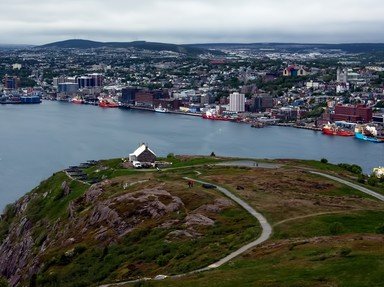Quiz Answer Key and Fun Facts
1. During the second part of our trip, my friend and I left Gros Morne National Park. As we drove along the Trans-Canada Highway through Newfoundland, we saw plenty of traps being stored along the side of the highway. What was the purpose of these traps?
2. In Bishop's Falls, Newfoundland, is an old railway trestle that was converted to a walking path. The Labrador region uses railway mainly for mining operations near the Quebec border. Does Newfoundland proper continue to operate a railway system?
3. Just outside of Gander was a monument dedicated to the victims of a major crash on December 12, 1985. What were the circumstances of this crash?
4. Continuing our journey along Highway 1 we stopped into Gambo, Newfoundland, the birthplace of Canada's "last Father of Confederation". What popular politician was dubbed this nickname?
5. After staying the night at Frenchman's Cove, we traveled to the small town of Fortune, Newfoundland to catch the ferry to St. Pierre and Miquelon. To do so, we drove across land that while rocky was mildly hilly but mainly flat.
Which of the following peninsulas would we have driven across to get to the ferry?
6. After we had returned from St. Pierre and Miquelon (which will be saved for a quiz all unto its own), we arrived in Newfoundland's capital city of St. John's. On a foggy, dreary, cooler day we visited Canada's most easterly point. During the Second World War, this site was used by the Canadian military as a gun battery. What is this easterly point called?
7. Most of the time we were in the Newfoundland capital city, the weather just wouldn't let up. We decided to tour the sites within an hour of the city so we checked out the community of Harbour Grace known for its fishing and military history. There was quite the monument that honors early aviation pioneers such as Amelia Earhart and Thor Solberg. What is the name of this monument?
8. In 1866, a cable was brought across the Atlantic Ocean and into Heart's Content, Newfoundland providing the first transatlantic communication from Europe to North America. In 1965, the Heart's Content Cable Station was closed for the last time due to which of the following technologies becoming obsolete?
9. Just prior to leaving the province of Newfoundland, we stopped at the remains of the Castle Hill fortifications that overlook Placentia Bay. In the 1600s, these fortifications were initially established by the French in order to protect which of the following industries?
10. At Argentia, Newfoundland we drove the truck aboard a passenger and vehicle ferry to embark on a 12-hour ride across what body of water, that landed us at North Sydney, Nova Scotia?
Source: Author
apathy100
This quiz was reviewed by FunTrivia editor
agony before going online.
Any errors found in FunTrivia content are routinely corrected through our feedback system.
